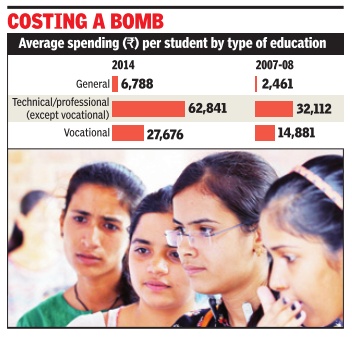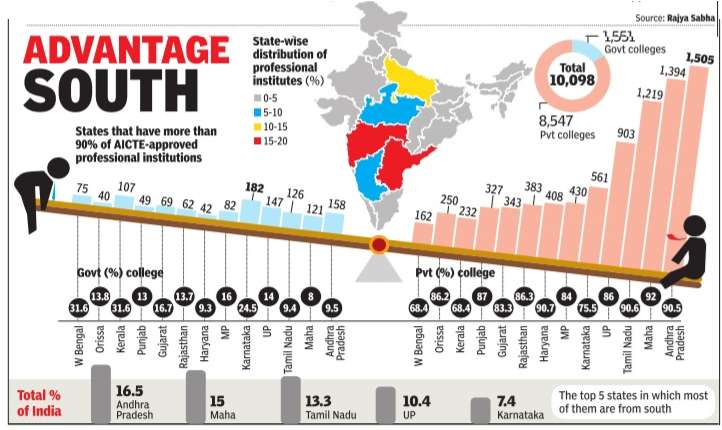Technical Education: India

This is a collection of articles archived for the excellence of their content. |
Technical education system in India
The source of the first part of this article INDIA 2012
A REFERENCE ANNUAL
Compiled by
RESEARCH, REFERENCE AND TRAINING DIVISION
PUBLICATIONS DIVISION
MINISTRY OF INFORMATION AND BROADCASTING
GOVERNMENT OF INDIA
The Technical Education System in the country covers courses in engineering,
technology, management, architecture, pharmacy, etc. The technical education
system in the country can be broadly classified into three categories: Central
Government funded institutions, State Government/State-funded institutions and
self financed institutions. In 2009-10, there were 65 centrally funded institutions in
the country. The Ministry of Human Resource Development caters to programmes
at undergraduate, postgraduate and research levels.
The technical education system at the central level comprises, among others, the following :
a) The All India Council for Technical Education (AICTE), which is the statutory body for proper planning and coordinated development of the technical education system;
b) Fifteen Indian Institutes of Technology (IITs);
c) Seven Indian Institutes of Management (IIMs);
d) One Indian Institute of Science (IISc), Bangalore;
e) Five Indian Institutes of Science Education and Research and f) Twenty National Institutes of Technology (NITs) (converted from RECs with 100 per cent Central funding).
Initiatives have been taken to promote research and education in basic sciences in the country. The IIS, Bangalore was sanctioned a special grant of Rs 100 crore to upgrade its infrastructure facilities, including laboratories. On the recommendation of the Scientific Advisory Council to the Prime Minister, two Indian Institutes of Science Education and Research have been approved at Pune and Kolkata. These Institutes will combine education in basic sciences at undergraduate and postgraduate level, with world class research facilities.
To enhance research productivity in Science and Technology Education and to improve quality of education, access to electronic journals and databases is being provided to all technical institutions. To benefit from lower costs, AICTE and Indian National Digital Library for Science and Technology (INDEST) have joined hands to form a combined AICTE-INDEST consortium.
In 2009-10, several measures were taken to implement the government's vision of providing increased access with equality and excellence. The setting up of new IITS, IIMS, IISEs, and assisting State governments in setting up new polytechnics and NITs are steps in this direction.
Technical Institutes in India
December 19, 2014
The demand for skilled workforce is growing in tandem with India's economic growth. But governmentgovt-aided professional institutes have not kept pace with the increasing demand for professional training. This gap is filled by private institutes that constitute 85% of AICTE-approved professional institutes in India. A little over 40% of such institutes are located in the four southern states. If we add Uttar Pradesh and Maharashtra, then these six states are home to about 66% of AICTE-approved professional institutes
Expenditure on technical education

The Times of India, Jul 03 2015
Mahendra Singh
Poll: Spend on tech courses 9 times of general education's
A student, opting for general education, on an average spent around Rs 6,788 in an academic session, Rs 62,841 for technical or professional education and Rs 27,676 for vocational course, reveals a government survey. According to a latest NSSO study , the private expenditure on technical professional courses and vocational education was about nine times and four times respectively than that on general education.
In 2007-08, the spending on technical courses and vocational education was 13 times and six times more as compared to general education.The survey found that the spending on technical education in private aided and unaided institutions varied between 1.5-2.5 times of that in government institutions.
The private expenditure was calculated as spending by students in the form of course fees (including tuition fees, examination fees etc.), purchase of books, stationery and uni forms, expenses on conveyance, private coaching, etc.Expense on course fee accounted for nearly 46% of the expenditure for general education and 73% of the expenditure for technical education.
The students pursuing general courses spent more (15%) on private coaching as against 3% for those pursuing technical and vocational education. Interestingly , those opting for general courses spent substantially more (22%) on books as compared to those doing technical courses (10%).
In states like Delhi, Haryana and Chandigarh the spending on general education was more than double of national average of Rs 6,788.It was also found that, at primary level expenditure per student in urban areas was Rs 10,083, more than four times than that in rural areas, pegged at Rs 2,811. The findings are part of a survey on “Social Consumption: Education“ (January to June 2014), conducted by the NSSO.
